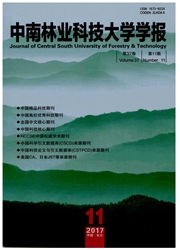

 中文摘要:
中文摘要:
城市近郊大型绿地的野生动物生态监测方法研究是一个普遍而尚未引起足够重视的课题。空间平衡抽样结合了简单随机抽样和系统抽样2种抽样方法的优点,对点状、线状、面状不同类型的调查对象具有较强的适应性。以南京东郊的大型哺乳动物河麂Hydropotes inermis为研究对象,以47个物种痕迹点和江苏基础地理信息数据库的8个环境变量为主要信息源,采用最大熵法(Maxent)生态位模型,建立潜在生境预测模型。在此基础上,分别采用反向随机四分递推栅格(RRQRR)、通用随机方格分层算法(GRTS)2种算法,进行空间平衡抽样,从生境适生概率、监测成本、调查难度3个方面建立评价指标来比较空间平衡抽样与系统抽样、随机抽样性能的优劣。结果表明:南京东郊河麂的潜在生境呈高度破碎化格局,距离公路距离(41.9%)、距离铁路距离(17.8%)、距离居民点距离(14.7%)3个与快速交通有关的因子的贡献率占了74.4%;当样本大小为200时,空间平衡抽样的抽样对象样本点平均适生概率平均为0.029 850 5,分别比简单随机抽样、系统抽样高了77.34%、68.30%,显示了较高的抽样精度;平均海拔、平均坡度分别为86.927 8 m、10.839 2°,略高于系统抽样、简单随机抽样;当采用样本点距主要道路平均距离来衡量监测成本时,空间平衡抽样监测成本(178.937 7 m)则较为显著地小于简单随机抽样、系统抽样。作为一种具有严格统计学基础的、高效低成本的、适应性强的抽样方法,空间平衡抽样在城市郊区野生动物监测中具有较大的应用潜力。
 英文摘要:
英文摘要:
Ecological monitoring research on wildlife in suburban large green space is a common problem which has not been paid sufficient attention.Spatial balanced sampling(SBS) method,a combination of systematic sampling(SS) and simple random sampling(SRS),has an advantage of sampling for different survey objects of point,linear and area.A large mammal of Chinese river deer(Hydropotes inermis) in eastern outskirts of Nanjing was selected as research objects,and 47 evidence data with coordinates,together with eight variables in basic geographic information database in Jiangsu were chosen as the main information sources to generate a potential habitat model of maximum entropy method(Maxent).Afterwards,two different algorithms of reversed randomized quadrant-recursive raster(RRQRR) and generalized random-tessellation stratified(GRTS) were applied to do SBS sampling,while suitable probability,monitoring cost and investigation difficulty were calculated to evaluate the performance of SBS,SS and SRS.Results show that the potential habitat of the wild animal was highly fragmented.Among the eight environmental factors,distance to roads(41.9%),distance to railway(17.8%) and distance to residential areas(14.7%),the three variables closely related with rapid traffic,account for 74.4% contribution to suitable probability of Chinese river deer.When sample size was equal to 200,compared with SS and SRS,the average suitable probability of RRQRR and GRTS was 0.029 850 5 for each sample point,increasing by 77.34% and 68.30% respectively,showing a high sampling accuracy.From point of investigation accessibility,the average elevation,average slope for sampling points of SBS was 86.927 8 m and 10.839 2 ° respectively,slightly higher than SS and SRS.Evaluated from indicator of monitoring cost in terms of average distance from sampling points to main roads,SBS was 178.937 7 m,which was significantly smaller than SS and SRS.As an efficient but low-cost,adaptable sampling method with a strictly statistic
 同期刊论文项目
同期刊论文项目
 同项目期刊论文
同项目期刊论文
 期刊信息
期刊信息
